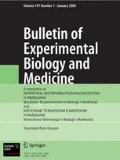We studied the structure of rhythms of BP, HR (by telemetric monitoring), electrolyte excretion (by capillary electrophoresis), and products of epiphyseal melatonin (by the urinary concentration of 6-sulfatoxymelatonin measured by ELISA) in normotensive Wistar-Kyoto rats and spontaneously hypertensive SHR rats maintained at 16/8 h and 20/4 h light-dark regimes. In Wister-Kyoto rats exposed to prolonged daylight, we observed changes in the amplitude, rhythm power (% of rhythm), and range of oscillations of systolic BP; HR mezor decreased. In SHR rats, mezor of HR also decreased, but other parameters of rhythms remained unchanged. Changes in electrolyte excretion were opposite in normo- and hypertensive rats. Under conditions of 20/4 h light-dark regime, daytime melatonin production tended to increase in normotensive rats and significantly increased in SHR rats. At the same time, nighttime melatonin production did not change in both normotensive and hypertensive animals. As the secretion of melatonin has similar features in animals of both lines, we can say that the epiphyseal component of the “biological clock” is not the only component of the functional system that determines the response of the studied rhythms to an increase in the duration of light exposure.
Similar content being viewed by others
References
Bespyatykh AYu, Brodskii VYa, Burlakova OV, Golichenkov VA, Voznesenskaya LA, Kolesnikov DB, Molchanov AYu, Rapoport SI. Melatonin: Theory and Practice. Rapoport SI, Golichenkov VA, eds. Moscow, 2009. Russian.
Chronobiology and Chronomedicine. Chibisov SM, Rapoport SI, Blagonravov ML, eds. Moscow, 2018. Russian.
Abeysuriya RG, Lockley SW, Robinson PA, Postnova S. A unified model of melatonin, 6-sulfatoxymelatonin, and sleep dynamics. J. Pineal Res. 2018;64(4). ID e12474. doi: https://doi.org/10.1111/jpi.12474
Amaral FGD, Cipolla-Neto J. A brief review about melatonin, a pineal hormone. Arch. Endocrinol. Metab. 2018;62(4):472-479.
Chang AM, Aeschbach D, Duffy JF, Czeisler CA. Evening use of light-emitting eReaders negatively affects sleep, circadian timing, and next morning alertness. Proc. Natl Acad. Sci. USA. 2015;112(4):1232-1237.
Chellappa SL, Lasauskaite R, Cajochen C. In a heartbeat: light and cardiovascular physiology. Front. Neurol. 2017;8. ID 541. doi: https://doi.org/10.3389/fneur.2017.00541
Davies TW, Smyth T. Why artificial light at night should be a focus for global change research in the 21st century. Glob. Chang. Biol. 2018;24(3):872-882.
Münch M, Nowozin C, Regente J, Bes F, De Zeeuw J, Hädel S, Wahnschaffe A, Kunz D. Blue-enriched morning light as a countermeasure to light at the wrong time: effects on cognition, sleepiness, sleep, and circadian phase. Neuropsychobiology. 2016;74(4):207-218.
Najjar RP, Wolf L, Taillard J, Schlangen LJ, Salam A, Cajochen C, Gronfier C. Chronic artificial blue-enriched white light is an effective countermeasure to delayed circadian phase and neurobehavioral decrements. PLoS One. 2014;9(7). ID e102827. doi: https://doi.org/10.1371/journal.pone.0102827
Reiter RJ, Tan DX, Korkmaz A, Erren TC, Piekarski C, Tamura H, Manchester LC. Light at night, chronodisruption, melatonin suppression, and cancer risk: a review. Crit. Rev. Oncog. 2007;13(4):303-328.
Simko F, Baka T, Paulis L, Reiter RJ. Elevated HR and nondipping HR as potential targets for melatonin: a review. J. Pineal Res. 2016;61(2):127-137.
Solocinski K, Gumz ML. The circadian clock in the regulation of renal rhythms. J. Biol. Rhythms. 2015;30(6):470-486.
Touitou Y, Reinberg A, Touitou D. Association between light at night, melatonin secretion, sleep deprivation, and the internal clock: Health impacts and mechanisms of circadian disruption. Life Sci. 2017;173:94-106.
Zuther P, Gorbey S, Lemmer B. Chronos-Fit 1.06, 2009. URL: http://chronos-fit.sharewarejunction.com
Author information
Authors and Affiliations
Corresponding author
Additional information
Translated from Byulleten’ Eksperimental’noi Biologii i Meditsiny, Vol. 168, No. 7, pp. 21-27, July, 2019
Rights and permissions
About this article
Cite this article
Blagonravov, M.L., Bryk, A.A., Medvedeva, E.V. et al. Structure of Rhythms of Blood Pressure, Heart Rate, Excretion of Electrolytes, and Secretion of Melatonin in Normotensive and Spontaneously Hypertensive Rats Maintained under Conditions of Prolonged Daylight Duration. Bull Exp Biol Med 168, 18–23 (2019). https://doi.org/10.1007/s10517-019-04636-4
Received:
Published:
Issue Date:
DOI: https://doi.org/10.1007/s10517-019-04636-4



